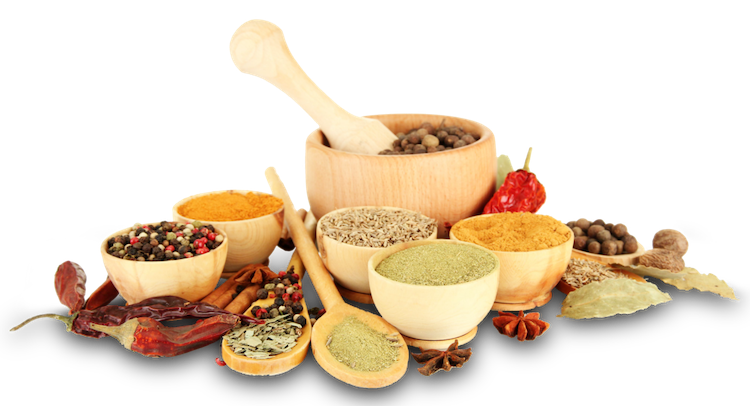Cheap Eats:
Murg Kashmiri
Kashmiri Chicken with Almonds and
Raisins
Often, when you ask people if they like Indian food, they respond, “No, sorry, I don’t like curry.” That comment represents the tip of a veritable iceberg of confusion regarding curry. It also indicates the speaker probably doesn’t know a lot about Indian food.
The confusion begins in India, but has spread far and wide along the lines of commerce and imperialism. The word curry comes from the Tamil word kari, and means “sauce” or “gravy.” That is still its meaning in India today. While possible to encounter flavors in Indian food that correspond to the taste often associated in the West with the word “curry”, Indian curry can also be a rich, buttery, tomato sauce; a thick, oniony brown sauce; a savory yogurt sauce; a smooth, flavorful spinach gravy; or an elegant, cream-based sauce with raisins and almonds.
However, there are myriad places that use the term curry to mean a specific flavor, or at least a limited range of flavors. India had a tremendous influence on Southeast Asia, particularly in the 4th through 6th centuries, but to some degree up until the 15th century. That influence, which was through trade, pilgrims, and a good bit of cultural imperialism, is why you find Buddhism, Hinduism, and curry pretty much throughout Southeast Asia. While variable within and among countries, the curries of Southeast Asia pretty much fall into a recognizable category that would be readily identified by Westerners as curry.
Enter the Europeans. India was where spices came from and getting to India was the whole point of exploration in the late 1400s. Spices from India had flowed steadily into the Middle East and Europe for several thousand years, but with th e fall of Constantinople to the Ottoman Turks in 1453, the flow was cut off and everyone tried to think of other ways of getting to India. Once they arrived, most Europeans decided they liked Indian food and when they went home, they didn’t want to leave behind the tastes they had learned to love. The little tins of yellow powder labeled, “curry”, in the grocery store are actually a blend of 6 to 12 spices that represent a colonial European attempt to replicate what they remembered as the vividness of Indian cuisine.
Now, Indian cooks create their own blends of spices, but those don’t taste anything like curry powder and they are not called curries. They are called masalas. When you walk through an Indian grocery store, you will likely see many jars with the word “masala” on them, such as chai tea masala. It means it’s spice for making whatever dish or beverage name appears before the word. Garam masala is simply a mix of dry spices for general use that can be purchased commercially.
But back to curry. Europeans did not simply take the flavor of “curry” home, they carried it everywhere. As a result, you find curried goat in Jamaica and Japanese curry is tied for first place with sushi at mealtimes in Japan. In Iceland, many fish dishes are enhanced with a dash of curry powder. England in particular has adopted the taste of India and while there are myriad wonderful, authentic Indian restaurants in England, there is almost no British home, no matter how traditional, without a tin of curry powder and/or a bottle of HP curry sauce.

So while I can accept the fact that some people don’t like curry (hard as it is for me to imagine), I do want you to take away from this the fact that, if you don’t like curry, it may rule out several Icelandic or Japanese dishes, and certainly applies to a number of Thai or Cambodian specialties, but it shouldn’t keep you from enjoying Indian food—at least not all of it.
The following dish is the first Indian recipe I ever tried (other than chai). It’s a perfect example of a curry that is unlike what one expects when the word “curry” is invoked. It is rich, elegant, and delicious. Enjoy.
Murg Kashmiri
(Kashmiri Chicken with Almonds and Raisins)
4 lb. chicken, cut up and skinned
Juice of ½ lemon
2 tsp. ground coriander
1 tsp. freshly ground black pepper
1 tsp. ground cardamom
⅛ tsp. ground cloves
1½ inch piece of fresh ginger, peeled and chopped
1 tsp. salt
½ tsp. hot chilli powder (see Note)
6 Tbs. butter
2 medium onions, chopped
1¼ cups heavy cream
⅓ cup slivered almonds
⅓ cup raisins
Preheat the oven to 400°F. Prick the chicken all over with a fork and rub it with the lemon juice.
Combine the coriander, pepper, cardamom, cloves, ginger, salt and chilli powder. Cream half the butter until light, then beat into the spice mixture. Rub this over the chicken. Put the chicken in a casserole or Dutch oven and roast for 15 minutes.
While the chicken roasts, melt the remaining butter in a saucepan. Add the onions and fry, stirring occasionally, until they are golden brown. Remove from the heat and stir in the cream, almonds, and raisins.
Reduce the oven to 350°F. Roast the chicken for one hour, or until cooked through, basting every 10 minutes with the cream mixture. Remove from the oven, arrange the pieces on a serving dish and keep warm.
Skim most of the fat from the surface of the cooking liquid and set the casserole over medium heat. Cook the sauce for two minutes, stirring constantly. Pour the sauce over the chicken and serve at once.
Serves 4.
Notes:
Chilli powder is not chili powder. Chilli with two ls is an Indian hot pepper. If you don’t have Indian chilli powder, use ground, hot red pepper or cayenne.

